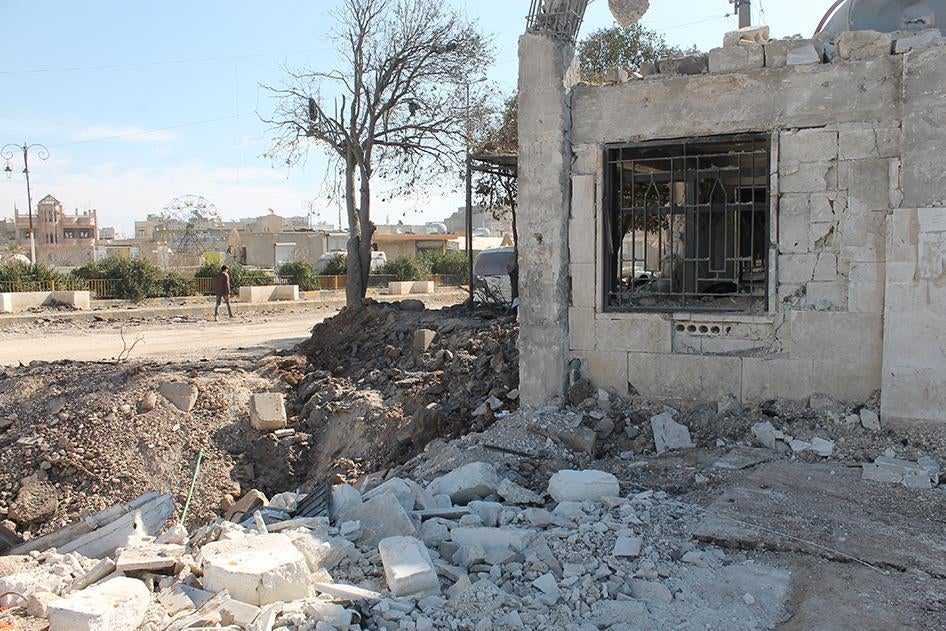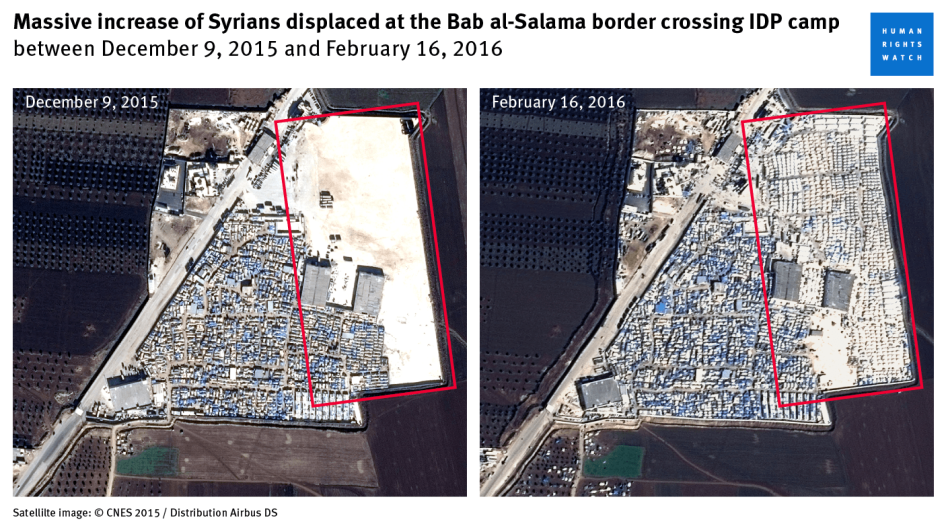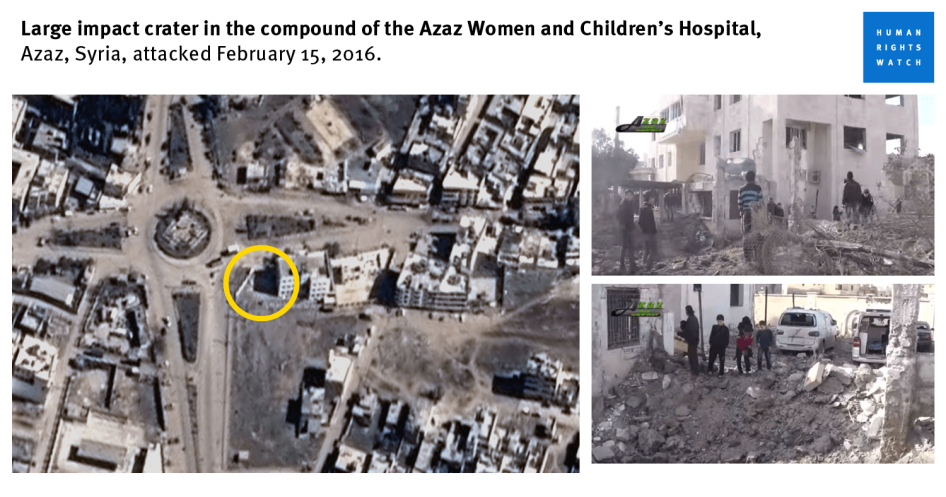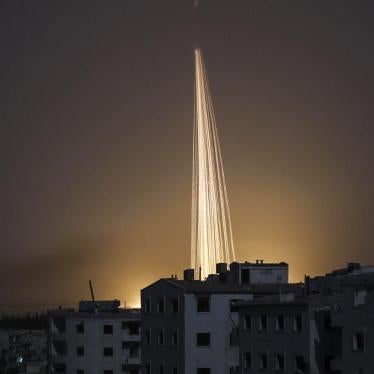(Beirut) – Attacks on Azaz and a neighboring town in northern Aleppo, Syria, hit two hospitals and a school used by displaced Syrians, killing at least 20 civilians. Witness statements and evidence of the aftermath indicates that the attacks on February 15, which also wounded 38, were part of the joint Russian-Syrian offensive in the area.
According to the United Nations, between February 1 and 16, at least 70,000 civilians fled the offensive to cut access between Aleppo city and the Turkish border. The area around Azaz has become the center of a multisided battle between various local, regional, and international actors.
“At this rate there will be little left, with schools, hospitals, and other facilities civilians depend on being wiped out,” said Nadim Houry, deputy Middle East director at Human Rights Watch. “Thousands of people fleeing the conflict are moving from place to place, but with the Turkish border closed, there’s nowhere for them to go. Turkey should open its borders to all who need protection.”
Syria and Russia should stop attacks targeting schools and hospitals and cease any indiscriminate attacks, including the use of cluster munitions, Human Rights Watch said. They should also stop using explosive weapons with wide-area effects, such as ballistic missiles, in populated areas.
Satellite imagery procured by Human Rights Watch shows a massive influx of displaced persons at a camp on the Syrian side of the Bab al-Salama border crossing with Turkey between December 9 and February 16. Human Rights Watch spoke with a camp leader who said that his camp, located at the border, had received more than 2,400 new families since February 1 and had no more space for new arrivals. Turkey should allow civilians trying to flee the area and who are currently stuck at its borders to enter and seek protection.
On February 12, the Syrian Kurdish People’s Protection Unit (YPG) forces, backed by Russian airstrikes, captured the Minnigh airbase, south of Azaz, from anti-government rebels, then continued their advance to the outskirts of Azaz, joined by allied armed groups from the Syrian Democratic Forces. Russian and Syrian government attacks continued in the area. Turkey began shelling YPG positions around Azaz from its border on February 13.
On February 15, between 8:15 and 8:30 a.m., the entrance of the Women and Children’s Hospital, located in Azaz city, was struck by what local activists described as a ballistic missile. The hospital was in use at the time as a medical facility. Two activists in Azaz told Human Rights Watch that it was across the road from a garage that served as a transport hub, and that the road saw heavy traffic. Syria Charity, which operates the hospital, told Human Rights Watch that 15 staff members were injured in the attack, four of them severely wounded.
A Human Rights Watch arms expert reviewed photographs of a missile that struck a field nearby and failed to detonate, identifying it as a ground-fired 9M79-series Tochka ballistic missile. The crater by the hospital, approximately seven meters across, is consistent with ballistic missile impact.
Only Syrian government forces have used ballistic missiles in Syria’s armed conflict so far. Syria stockpiles several types of ballistic missiles, according to the authoritative publication The Military Balance, from the International Institute of Strategic Studies. They include Scud missiles, variants of Scud missiles, SS-21 Tochka missiles, and Luna-M missiles.
Three local activists told Human Rights Watch that after the hospital was hit, there were also airstrikes on the city. While the Kurdish YPG forces and allied armed groups advanced to the outskirts of Azaz, the hospital was located in the city proper, four to five kilometers from the front line. Four local residents told Human Rights Watch there was no military target nearby.
An activist and a doctor, both in Azaz, told Human Rights Watch that the Azaz National Hospital was also struck during the same period. The National Hospital was located near the frontlines and had been evacuated 10 days earlier, the activist said. The doctor, who works at the Azaz Ahly Hospital, said it is the only one of three hospitals in Azaz that remain open after the February 15 attacks.
In addition to local residents, Azaz city hosts nearly 12,000 newly displaced persons from around Aleppo. The number of displaced living in Azaz has increased significantly in the last two weeks, as people fleeing aerial bombardment and ground battles in other parts of Aleppo governorate have sought shelter there, unable to cross the border to Turkey.
Deliberate or reckless attacks against civilians and civilian structures committed with criminal intent are war crimes. The laws of war require that the parties to a conflict take constant care during military operations to spare the civilian population and to “take all feasible precautions” to avoid or minimize the incidental loss of civilian life and damage to civilian objects. When used in populated areas, ballistic missiles with large payloads of high explosives have a wide-area destructive effect, and it is not possible when using them to distinguish adequately between civilians and fighters, which almost inevitably leads to civilian casualties. Using these weapons against Azaz, a civilian populated area, would constitute a war crime. Hospitals and other medical facilities are civilian objects that have special protections under the laws of war.
Also at 8:30 a.m. on February 15, in the village of Kaljabrin, about eight kilometers southeast of Azaz, a school where displaced people had been staying was attacked, also likely by Syrian government forces. Mazen Ibrahim, a director at the Resala Foundation and a displaced person who was staying at the school, told Human Rights Watch that he and his relatives heard the previous day that Kaljabrin would be attacked soon. Most of the displaced left the night before, but fearing shelling en route, a group, including Ibrahim’s family, planned to leave that morning. As he stood in the street waiting for a van to transport them, the school was struck. Fifteen of his relatives were killed or injured in the attack, he said, ranging in age from one month to 60 years.
Human Rights Watch reviewed footage of the victims after the attack, as well as photographs showing the remnants of a ballistic missile lying in fields near Kaljabrin that day. Human Rights Watch’s arms expert identified the item as a 9M79M Tochka missile, with a range of 180 kilometers.
Human Rights Watch cannot establish the type of warhead carried by the missile, or whether it struck the school. Descriptions of the attack by residents are consistent with a cluster munition attack. Tochka missiles can carry a 9N24 warhead containing 50 explosive submunitions.
Two people present during the attack said they heard multiple smaller explosions, indicating that the missile may have been carrying a cluster munition warhead. Ibrahim said he heard “fire all around” and “many” explosions. He said: “when it was over, people were dead.” Human Rights Watch reviewed video footage of people killed and wounded in the attack; the damage and wound patterns are consistent with fragmentation injuries caused by exploding submunitions.
Doctor Mohammed al-Laqhini, director of the Azaz Ahly Hospital, which received injured people from both incidents, told Human Rights Watch that a security guard and an ambulance driver from the Women and Children’s Hospital were among the injured, and that he saw women and children among the victims. A list compiled by local activists recorded 20 deaths and 38 injured in the attacks on Azaz and Kaljabrin that day. A representative of the Independent Doctors Association, which runs a field hospital on the Syrian side of the Syria-Turkey border, told Human Rights Watch the hospital received 49 injured people on February 15, after attacks on Azaz, Kaljabrin, and Tel Refaat, another town nearby.
“Syrians fleeing bombing in the Azaz enclave aren’t even safe in the places they’ve sought shelter, but there are so few places for them to go,” said Houry. “In just one day, this small area saw two hospitals and a school housing the displaced hit, injuring or killing dozens.”
A total of seven medical facilities and two schools were struck in Syria on February 15, killing nearly 50 civilians, according to international organizations working in the country. In Maaret al-Nu`man, in Syria’s Idlib governorate, a hospital supported by Médecins Sans Frontières (MSF) was also struck, the group reported. A representative of the group told Reuters he thought that either Russia or Syrian government forces were responsible. MSF confirmed that at least 11 died after the hospital was struck by four missiles that hit within a few minutes of each other. Ayman al-Yasouf, a pharmacist who rushed to the scene, told Human Rights Watch that the strike happened around 9:10 a.m. “[The hospital] was three stories high and the entire building is now on the ground and completely destroyed,” he said. He added that the nearby National Hospital, where those injured in the MSF strike were taken, was struck multiple times that morning, starting at 11:15 a.m.
In late January 2016, Syrian government forces, backed by Russian airstrikes, began an offensive in northern Syria to break the siege imposed by armed opposition groups on the towns of Nubbul and Zahraa and to cut off the city of Aleppo from Turkey. In line with Turkey’s one-year-old border closure policy with Syria, only those with serious medical injuries are allowed to cross at the Öncüpınar/Bab al-Salama border crossing. The rest have fled to Azaz and Afrin or to eight camps for internally displaced people located east of Azaz along the border. Aid workers say the camps sheltered 40,000 displaced Syrians before the recent crisis and are now filled beyond capacity.
Selected quotes from witnesses:
“I cannot describe [the scene], people were scared, afraid, terrified…they kept asking me, ‘Doctor, what should we do, where should we go, how can we evacuate?’ … One person fainted. [Many people] were crying … We had to evacuate six infants, nine children, nine women, all of them patients. Some patients were transferred to other hospitals, and some had to get homes, there is no place to go. Five thousand people benefit from our care each month and now we are closed.”
– Dr. Zakariya Mubara, director of the Women and Children’s Hospital
“The first strike happened at 9:10 a.m. and the Syria Civil Defense rushed to try to save people. The hospital was new, about four months old…it was three stories high and the entire building is now on the ground and completely destroyed. At 9:30 a.m. as the Civil Defense was trying to rescue people, the hospital was struck a second time. There were 30 injured from the strikes and they were taken to the National Hospital, four kilometers away, which itself was struck at 11:15 a.m. and then two more times at 11:45 a.m. and then 12:15 a.m.”
– Ayman al-Youssef, pharmacist and head of the Union of Medical Care and Relief Organizations, who witnessed the aftermath of the strike on the MSF hospital














